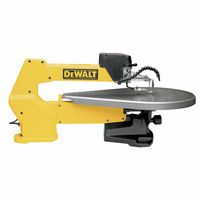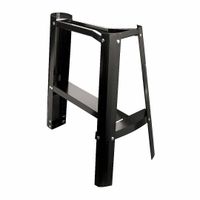Call +(254) 703 030 000 / 751 483 999 / 721 704 777
- Home
- Tools
- Power Tools
- Power Saws Blades
- Scroll Saws
.....Read More
Frequently Asked Questions
What is a scroll saw used for?
A scroll saw is a specialized power tool used for making intricate cuts and detailed designs in various materials, primarily wood, but also metal, plastic, and other materials. It features a fine, thin blade that moves up and down rapidly, allowing for precise control and the ability to cut complex shapes, curves, and patterns that would be difficult or impossible with other saws.
Scroll saws are particularly valued in woodworking and crafts for their ability to create detailed fretwork, inlays, and marquetry. They are commonly used by hobbyists, artisans, and professional woodworkers to produce decorative items, puzzles, intarsia, and custom furniture components. The saw's design allows for internal cuts without needing to cut through the edge of the material, which is achieved by threading the blade through a pre-drilled hole in the workpiece.
The tool's variable speed control and tilting table enhance its versatility, enabling users to adjust the cutting speed for different materials and to make angled cuts. The scroll saw's ability to handle delicate and intricate work makes it ideal for projects requiring precision and fine detail, such as making wooden toys, ornaments, and intricate patterns.
Overall, the scroll saw is an essential tool for anyone involved in detailed woodworking or crafting, offering the ability to execute complex designs with accuracy and ease.
How do you change a blade on a scroll saw?
1. **Turn Off and Unplug**: Ensure the scroll saw is turned off and unplugged from the power source to prevent accidental starts.
2. **Release Tension**: Locate the tension knob or lever, usually found at the back or top of the saw, and release the blade tension by turning or flipping it.
3. **Remove Blade Guards**: If your scroll saw has blade guards or covers, remove them to access the blade more easily.
4. **Loosen Blade Clamps**: Identify the blade clamps, which are typically located at the top and bottom of the blade. Use the appropriate tool (often an Allen wrench or a knob) to loosen the clamps.
5. **Remove Old Blade**: Carefully remove the old blade from the clamps. Note the direction of the teeth, as the new blade must be installed in the same orientation.
6. **Insert New Blade**: Position the new blade with the teeth facing the correct direction (usually downward). Insert the blade into the bottom clamp first, ensuring it is seated properly, then into the top clamp.
7. **Tighten Blade Clamps**: Secure the new blade by tightening the clamps. Ensure the blade is straight and properly aligned.
8. **Reapply Tension**: Re-engage the tension by turning the knob or flipping the lever back to its original position. The blade should be taut but not overly tight.
9. **Check Blade Alignment**: Ensure the blade is aligned correctly and moves freely without wobbling.
10. **Replace Blade Guards**: Reattach any blade guards or covers that were removed.
11. **Test the Saw**: Plug the saw back in and turn it on briefly to ensure the blade is functioning correctly and is securely installed.
What materials can a scroll saw cut?
A scroll saw is a versatile tool capable of cutting a variety of materials with precision. Primarily, it is used for intricate and detailed cuts, making it ideal for crafting and fine woodworking projects. Here are the materials a scroll saw can cut:
1. **Wood**: Scroll saws are most commonly used for cutting wood. They can handle a range of wood types, from softwoods like pine and cedar to hardwoods such as oak, maple, and walnut. The thickness of the wood can vary, but typically, scroll saws are best suited for pieces up to 2 inches thick.
2. **Plywood and Veneers**: These materials are often used in scroll saw projects due to their thinness and ease of cutting. Scroll saws can cut through various grades and thicknesses of plywood and veneers, allowing for detailed designs.
3. **Plastics**: Scroll saws can cut through certain plastics, such as acrylic and plexiglass. It is important to use the appropriate blade and speed settings to prevent melting or chipping.
4. **Metals**: With the right blade, scroll saws can cut non-ferrous metals like aluminum, brass, and copper. The metal should be relatively thin, usually up to 1/8 inch thick, to ensure clean cuts.
5. **Foam and Rubber**: These materials can be cut with a scroll saw, making it useful for crafting and model-making. The saw can handle various densities and thicknesses of foam and rubber.
6. **Leather**: Scroll saws can also cut leather, allowing for intricate designs in leatherworking projects.
When cutting any material, it is crucial to select the appropriate blade type and adjust the saw's speed settings to match the material's properties, ensuring clean and precise cuts.
How do you make intricate cuts with a scroll saw?
To make intricate cuts with a scroll saw, follow these steps:
1. **Select the Right Blade**: Choose a fine-toothed blade suitable for intricate cuts. The blade should match the material's thickness and hardness.
2. **Prepare the Material**: Securely attach the pattern to the workpiece using adhesive spray or masking tape. Ensure the material is flat and free of debris.
3. **Adjust the Scroll Saw**: Set the saw's speed according to the material. Use a slower speed for harder materials and intricate designs to maintain control.
4. **Install the Blade**: Properly tension the blade by following the manufacturer's instructions. Ensure it is straight and securely fastened.
5. **Position the Workpiece**: Place the workpiece on the saw table, ensuring it is stable. Align the starting point of the cut with the blade.
6. **Start Cutting**: Turn on the saw and gently guide the workpiece into the blade. Use both hands to control the material, keeping fingers away from the blade.
7. **Follow the Pattern**: Carefully maneuver the workpiece along the pattern lines. For tight curves, make gradual turns and use relief cuts to prevent binding.
8. **Maintain Control**: Keep a steady pace and avoid forcing the material. Let the blade do the cutting to prevent breakage and ensure precision.
9. **Use a Foot Pedal**: If available, use a foot pedal to control the saw, allowing both hands to guide the workpiece.
10. **Finish the Cut**: Once the cut is complete, turn off the saw and remove the workpiece. Sand any rough edges for a smooth finish.
11. **Safety Precautions**: Always wear safety goggles and ensure the work area is well-lit and free of distractions.
What is the difference between a scroll saw and a band saw?
A scroll saw and a band saw are both used for cutting wood and other materials, but they have distinct differences in design, function, and application.
A scroll saw is a small, stationary saw with a fine, reciprocating blade that moves up and down. It is primarily used for intricate, detailed cuts, such as curves, patterns, and interior cutouts. The blade is thin and allows for tight turns, making it ideal for delicate work like marquetry, intarsia, and fretwork. Scroll saws are often used by hobbyists and artisans for precision work. They typically have a variable speed control, allowing for adjustments based on the material being cut.
In contrast, a band saw features a continuous loop blade that moves in a single direction around two or more wheels. It is more robust and versatile, capable of handling larger and thicker materials. Band saws are used for straight cuts, resawing, and cutting irregular shapes, but they are not as precise as scroll saws for intricate details. They are commonly used in woodworking shops for tasks like ripping lumber, cutting veneers, and processing rough stock. Band saws can also cut metal and other materials with the appropriate blade.
In summary, the main differences lie in their blade design and intended use: scroll saws are for detailed, intricate work with a reciprocating blade, while band saws are for larger, more general-purpose cutting with a continuous loop blade.
How do you maintain a scroll saw?
To maintain a scroll saw, follow these steps:
1. **Regular Cleaning**: After each use, clean the saw to remove dust and debris. Use a vacuum or compressed air to clear sawdust from the table, blade, and motor housing.
2. **Blade Maintenance**: Regularly inspect blades for wear and replace them when dull or damaged. Ensure the blade is properly tensioned and aligned to prevent breakage and ensure accurate cuts.
3. **Lubrication**: Periodically lubricate moving parts such as the arm pivots and bearings with a light machine oil to ensure smooth operation. Avoid over-lubricating, which can attract dust.
4. **Check the Table**: Ensure the table is flat and free of rust. If rust is present, clean it with a rust remover and apply a protective wax to prevent future rusting.
5. **Inspect the Motor**: Check the motor for unusual noises or overheating. Ensure the motor is securely mounted and the drive belt is in good condition and properly tensioned.
6. **Tension and Alignment**: Regularly check the blade tension and alignment. Proper tension prevents blade breakage and ensures precise cuts. Adjust the blade alignment to ensure it is perpendicular to the table.
7. **Electrical Components**: Inspect the power cord and switch for wear or damage. Replace any frayed cords or faulty switches to prevent electrical hazards.
8. **Dust Collection**: If your scroll saw has a dust collection port, ensure it is clear and connected to a dust collection system to minimize airborne dust.
9. **User Manual**: Refer to the user manual for specific maintenance instructions and recommended service intervals for your particular model.
10. **Storage**: Store the scroll saw in a dry, clean environment to prevent rust and damage.
Regular maintenance ensures the longevity and performance of your scroll saw, providing safe and accurate operation.
What safety precautions should be taken when using a scroll saw?
1. **Read the Manual**: Familiarize yourself with the manufacturer's instructions and safety guidelines specific to your scroll saw model.
2. **Wear Safety Gear**: Use safety glasses or goggles to protect your eyes from debris. Wear a dust mask to avoid inhaling sawdust, and use hearing protection if necessary.
3. **Secure the Work Area**: Ensure the work area is clean, well-lit, and free of clutter. Secure the scroll saw to a stable surface to prevent movement during operation.
4. **Inspect the Saw**: Check the scroll saw for any damage or wear. Ensure the blade is sharp, properly installed, and tensioned according to the manufacturer's specifications.
5. **Use the Right Blade**: Select the appropriate blade for the material and type of cut. Ensure it is suitable for the thickness and hardness of the material.
6. **Adjust Blade Tension and Speed**: Set the blade tension and speed according to the material being cut. Proper tension prevents blade breakage, and the correct speed ensures clean cuts.
7. **Secure the Material**: Use clamps or a hold-down foot to secure the material to the table, preventing it from moving during cutting.
8. **Keep Hands Safe**: Keep fingers at a safe distance from the blade. Use push sticks or other tools to guide small pieces of material.
9. **Avoid Loose Clothing**: Do not wear loose clothing, jewelry, or anything that could get caught in the saw. Tie back long hair.
10. **Stay Focused**: Concentrate on the task and avoid distractions. Do not operate the saw if you are tired or under the influence of substances.
11. **Turn Off When Not in Use**: Always turn off and unplug the scroll saw when changing blades, making adjustments, or when not in use.
12. **Emergency Preparedness**: Know the location of the emergency stop button and first aid kit. Be prepared to respond quickly in case of an accident.

